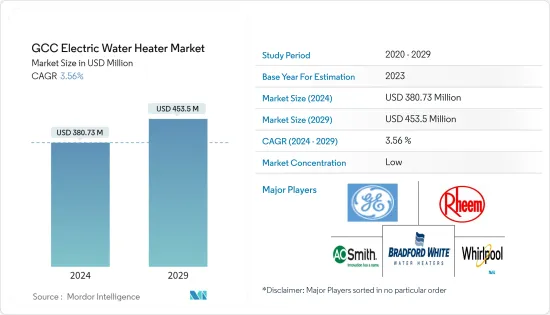PUBLISHER: Mordor Intelligence | PRODUCT CODE: 1537710

PUBLISHER: Mordor Intelligence | PRODUCT CODE: 1537710
GCC Electric Water Heater - Market Share Analysis, Industry Trends & Statistics, Growth Forecasts (2024 - 2029)
The GCC Electric Water Heater Market size is estimated at USD 380.73 million in 2024, and is expected to reach USD 453.5 million by 2029, growing at a CAGR of 3.56% during the forecast period (2024-2029).

The GCC electric water heater market is witnessing robust growth, with projections indicating a continued upward trajectory. The GCC region's rapid urbanization, infrastructure development, and increasing disposable incomes are key drivers behind the surging demand for electric water heaters. Notably, the market's expansion is propelled by the growing preference for eco-friendly and energy-efficient products. Electric water heaters are gaining prominence over traditional gas or fuel-powered counterparts due to their lower carbon emissions, enhanced safety features, and user-friendly installation. Technological advancements have further bolstered the market, with energy-efficient electric water heaters offering reduced operating costs and energy consumption.
The GCC's urbanization surge, coupled with a rising population, has spurred the demand for residential and commercial infrastructure, leading to a rise in electric water heater installations. As living standards improve and consumer preferences gravitate towards modern conveniences, a reliable hot water supply becomes paramount, further fueling market growth. Moreover, the GCC's predominantly hot climate necessitates electric water heaters for various daily tasks, such as cooking and cleaning, ensuring a consistent demand for these appliances.
GCC Electric Water Heater Market Trends
Residential Electric Water Heaters Lead the Market, Fueled by Urbanization and Sustainability Focus
Driven by a confluence of factors, the market for residential electric water heaters is poised to dominate. Countries like Saudi Arabia, the UAE, and Qatar are witnessing rapid population growth, urbanization, and a surge in residential construction, including apartments and villas. This surge is fueling a sustained demand for hot water solutions. As residents strive for modernization and improved living standards, electric water heaters have become essential, catering to daily needs like bathing, cooking, and cleaning. Despite the region's predominantly hot climate, the demand for hot water remains consistent, especially during cooler months and evenings, driving the adoption of electric water heaters.
Furthermore, a growing emphasis on energy efficiency and sustainability, bolstered by government initiatives promoting eco-friendly appliances, propels the demand for energy-efficient models. This demand is further bolstered by technological advancements in electric water heaters, such as heat pump systems and smart features, which offer heightened efficiency and convenience.
Saudi Arabia's Electric Water Heater Market Set for Robust Growth, Fueled by Urbanization and Government Initiatives
Saudi Arabia is emerging as a dominant force in the electric water heater market, particularly within the Gulf Cooperation Council (GCC) region. This sector has experienced significant expansion in recent years, driven by factors like urbanization, population growth, and a rising preference for energy-efficient solutions. A key impetus behind Saudi Arabia's electric water heater market boom is its swiftly growing population, forecasted to reach 38 million by 2030. In tandem, the country has witnessed a marked upswing in infrastructure development, with a notable emphasis on residential and commercial projects, consequently fueling the demand for electric water heaters.
Adding to this momentum, Saudi Arabia's Vision 2030 initiative, aimed at expanding the economy and decreasing oil reliance, has allocated substantial investments to infrastructure, particularly in the housing sector. These endeavors are poised to amplify the demand for electric water heaters further. Moreover, the government's commitment to energy efficiency, underscored by the introduction of regulations and standards, bolsters the market's growth trajectory and aligns with a broader sustainability agenda.
GCC Electric Water Heater Industry Overview
The competitive landscape of the GCC electric water heater market is fragmented by the presence of key players such as A. O. Smith Corporation, Rheem Manufacturing Company, Whirlpool, General Electric Co., and Bradford White Corporation. These companies compete based on factors including product quality, brand reputation, pricing strategies, distribution networks, and technological innovations. Market competition is further intensified by the presence of regional players and increasing emphasis on energy efficiency and sustainability in product offerings.
Additional Benefits:
- The market estimate (ME) sheet in Excel format
- 3 months of analyst support
TABLE OF CONTENTS
1 INTRODUCTION
- 1.1 Study Assumptions and Market Definition
- 1.2 Scope of the Study
2 RESEARCH METHODOLOGY
3 EXECUTIVE SUMMARY
4 MARKET DYNAMICS AND INSIGHTS
- 4.1 Market Overview
- 4.2 Market Drivers
- 4.2.1 Increasing Residential and Commercial Construction Activities
- 4.3 Market Restraints
- 4.3.1 Alternative Water Heating Technologies, Such as Solar Water Heaters and Heat Pump Systems
- 4.4 Market Opportunities
- 4.4.1 Collaborations and Partnerships with Construction Companies
- 4.4.2 Technological Advancements such as Energy-Efficient Models and Smart Features
- 4.5 Value Chain Analysis
- 4.6 Industry Attractiveness: Porter's Five Forces Analysis
- 4.6.1 Threat of New Entrants
- 4.6.2 Bargaining Power of Buyers
- 4.6.3 Bargaining Power of Suppliers
- 4.6.4 Threat of Substitutes
- 4.6.5 Intensity of Competitive Rivalry
- 4.7 Insights on the Impact of Technology and Innovation
- 4.8 Impact of COVID-19 on the Market
5 MARKET SEGMENTATION
- 5.1 By Product Type
- 5.1.1 Storage Tank Water Heaters
- 5.1.2 Tankless Water Heaters
- 5.2 By Capacity
- 5.2.1 Small
- 5.2.2 Medium
- 5.2.3 Large
- 5.3 By End Users
- 5.3.1 Commercial
- 5.3.2 Residential
- 5.4 By Distribution Channel
- 5.4.1 Online
- 5.4.2 Offline
- 5.5 By Geography
- 5.5.1 United Arab Emirates
- 5.5.2 Bahrain
- 5.5.3 Saudi Arabia
- 5.5.4 Oman
- 5.5.5 Qatar
- 5.5.6 Kuwait
6 COMPETITIVE LANDSCAPE
- 6.1 Market Concentration Overview
- 6.2 Company Profiles
- 6.2.1 Whirlpool
- 6.2.2 General Electric Co.
- 6.2.3 Rheem Manufacturing Company
- 6.2.4 A.O. Smith Corp.
- 6.2.5 Bradford white
- 6.2.6 Bajaj
- 6.2.7 Rinnai Corporation
- 6.2.8 Haier Inc.
- 6.2.9 Havells India Ltd
- 6.2.10 Lennox International Inc.*
7 FUTURE MARKET TRENDS
8 DISCLAIMER AND ABOUT US




